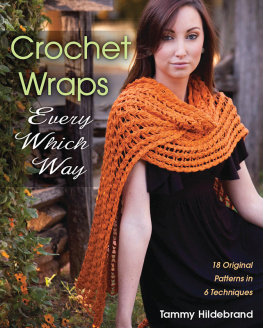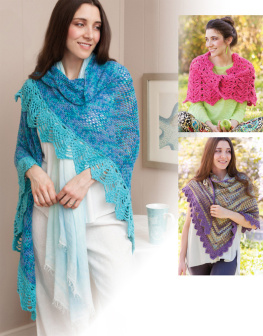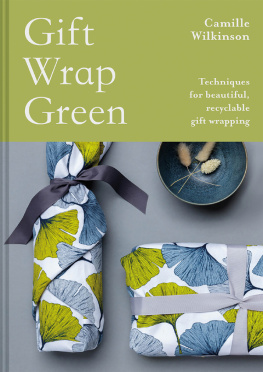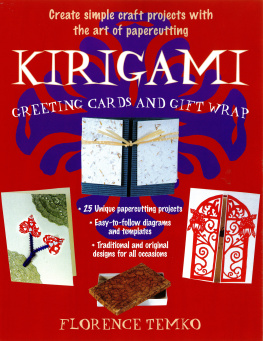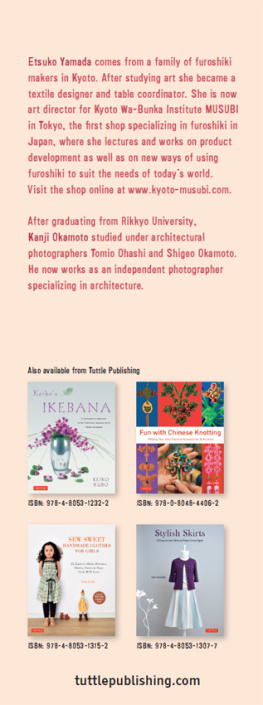The PixeladiesDeb Cashatt and Kris Sazakiare quilt artists, teachers, pattern designers, and owners of Pixeladies, a fiber arts and custom fabric printing studio.
Dedication
This book is dedicated to Debs mom, Meada, and Kriss mom, Gladys. They are the ones who passed down to us their love of fabric in their own singular ways. Okay, so Debs mom is an accomplished seamstress and Kriss mom had a seamstress, but whos worried about the details!
Acknowledgments
While there are so many people to thank for helping us on this bookmaking journey, we would especially like to thank the following:
For their expertise in the Japanese culture and languageHaruo Sazaki and Naoko Masuno.
For their technical assistanceDonna Komure-Toyama, Jenny Lyon, and the supportive C&T Publishing team.
For their contributions of fabric and other materialsThe Batik Butik Inc.; Jacquard Inkjet Fabric Systems; Karma Kraft LLC; OLFANorth America Division; The Rain Shed Inc.; Robert Kaufman Fabrics; Rupert, Gibbon & Spider, Inc.; and Spoonflower, Inc.
For their artistic contributions to our galleryAnn Ragland Bowns, Judith Content, Franki Kohier, Carol Larson, Noelle Tamborini-Olson, and Sandra Wagner.
For inviting us to give our first furoshiki demonstration, even though they werent quite sure what we were going to doGold Bug Quilters of El Dorado County, Placerville, California.
For holding an inspiring meeting on how to get publishedNorthern California Quilt Council.
For their ongoing financial and emotional supportDave Leippe and Neil Matsuoka.
And for Kriss Auntie Yuki, who never failed to show up at a family gathering with something wrapped in a furoshiki.

Preface
It all started at a guild meeting. The members arrived with their signature potluck dishes. Kris brought hersartichoke frittatabut she had wrapped her platter in a furoshiki. Furoshiki (pronounced foo-roe-shkee) is the Japanese word for wrapping cloth. On this particular occasion, Kris used a dark blue and white cotton furoshiki that she had received as a wedding gift. She had also used one of the simplest wraps there istwo square knots. We couldnt believe the compliments Kris received on this simple wrap: How beautiful! Its gorgeous! How did you do that? What a great idea, and you didnt waste plastic or paper!
Something similar happened at another meeting soon thereafter. We quickly realized that fabric lovers appreciated a new, creative use for fabric and would probably enjoy learning how to wrap various items in furoshiki. The next time a guild contacted us for a presentation, we wondered aloud if the guild members would be interested in a hands-on demonstration. Well, they were, and we have been having so much fun ever since, showing people how versatile a square of fabric can be, that we thought you too would want to learn some great techniques. Having grown up using furoshiki, it was an everyday thing for Kris, but we realized how we could make furoshiki an everyday, fun activity for everyone. So heres hoping youll enjoy wrapping furoshiki as much as we do and will show other people how to do it, too. We have even included individual project instruction cards in the back of this book for quick reference. Give a card along with the gift wrapped in furoshiki, so that the recipient can replicate the wrap. Anyone from age 5 to 105 can do it!
Introduction

Kris with her son, Miles, in 1992
Its universal. All cultures have a rich tradition in fiber. When it comes to wrapping and carrying items, many cultures know how handy and flexible a piece of cloth can be. Just think of the many photos youve seen of European immigrants passing through Ellis Island on their way to America, some of them holding their belongings wrapped in fabric bundles. Think of colorful African head wraps, which are done with one rectangle of fabric. Dont forget sarongs and pareos, wrap-around skirts that need only be tucked in to stay on the body. Its simple clothing at its best. And, what better way to carry the most precious gift, your baby, than in a rebozo, or fabric sling? Still popular in Central America, its use there dates back to the Mayan civilization. Beyond that, youll find countless women (and men!) in different cultures throughout the world cradling their little ones in a traditional fabric sling.
The Japanese, though, seem to have a special relationship with packaging. You might even say they have an obsession with it. If youve ever been to Japan, you may have peeked into a Japanese grocery store to find individually wrapped fruit. You can also find delicious cookies individually wrapped, placed in plastic compartments in a tin encased in a cardboard sleeve, and beautifully wrapped in gift paper! Its really all about a Japanese appreciation for shape and presentation. Its no wonder, then, that the Japanese took the simple cloth wrap, furoshiki, and created beautiful wraps. Many of you are probably familiar with the Japanese art of paper folding called origami. Just think of furoshiki as origami for fabric, but with fabric you get to tie knots! Not only that, but you can create and use furoshiki even if you dont sew.

Modern furoshiki, packaged for sale

Furoshiki from the authors collections
The use of furoshiki in Japan dates back centuries. Originally used to wrap the clothes of the nobility, the wrapping cloth was known as hira zutsumi. When public baths became popular, people used the wrapping cloth to carry clothes to and from the bathhouses, and the wrap came to be known as furoshiki: literally translated as bath spread. During the Edo period (16031868), the furoshiki gained popularity among the rising merchant class, who exploited its potential for carrying goods. Sadly, furoshiki lost popularity with the introduction of paper and plastic bags.
Eco-Friendly Wrap
The single-use plastic bag has created an ecological nightmare. Estimates on worldwide consumption vary between 500 billion and a trillion plastic bags per year. That would seem like enough to fill an ocean. In fact, a collection of litter is accumulating in the currents of the North Pacific Ocean. Known as the Great Pacific Garbage Patch, this mass of garbage, which includes countless plastic bags, is estimated to be larger than the state of Texas.
There is a better way. In 2006, Yuriko Koike, who was Japans minister of the environment at the time, introduced the mottainai furoshiki to encourage people to use furoshiki to reduce waste. This particular furoshiki was made from recycled PET bottles and was decorated with a painting by the eighteenth-century Japanese painter Jakuchu Ito. Mottainai usually translates as wasteful, but the Japanese have put a lot of oomph into this word so that the meaning it conveys is more like, Boy, its a shame to waste this thing and not realize its full value. By making and reusing furoshiki instead of plastic bags and paper, you can help reduce waste. And, youll be creating a beautiful work of art every time you wrap something.

Next page
